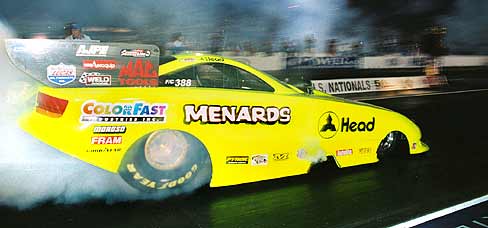|

10/11/04
Let's Ban The Burnout

Jeff
Burk Photo
Remember when race cars got faster and the
show got slower? Now that the subject of slowing
down the fuel cars is getting serious debate
by racers and rulesmakers, let's do something
about speeding up the show.
Entertainment and media experts have long
insisted that the optimum length for any recreational
activity is three hours. This is one reason
for NASCAR's popularity, particularly among "television
fans." The unique case of contemporary
drag racing -- with its multiple pro categories
and multiple days of qualifying, plus eliminations
-- obviously doesn't fit this formula. That's
not to say it never has, however, as anyone
who attended San Fernando Raceway can confirm.
Surrounded by homes and adjacent to a church
with a cranky minister, the infamous Frog Pond
was forced to contend with a Sunday noise curfew
so restrictive that entire eight-car Top Fuel,
Top Gas and Little Eliminator shows -- qualifying
plus eliminations -- were completed between
12:30 and 3:30 p.m. Not only that, but trophy
winners in a couple of dozen "uncorked" classes
(Altered, Dragster, Gas, Modified Production,
Modified Sports) were also determined during
that three-hour span. What a live-TV show THAT
would've made on Sunday afternoons!
Saturday-night strips such as Lions were more
fortunate, offering virtually unlimited numbers
of qualifying runs during afternoon hours. Nevertheless,
eliminations in multiple feature categories
were run off in three to four hours. Most fans
arrived not long before the national anthem,
and were back on the San Diego Freeway by 11
o'clock. They didn't need six or seven hours
of entertainment then, and they sure don't
need to sit on hard seats for more than three
or four hours now.
Among all of the contributing factors that
combined to stretch national events into all-day
marathons in the late 1970s and 1980s, perhaps
none is more responsible nor less necessary
than the burnout. What started out as a beneficial
spin through the resin on slippery, asphalt
starting lines in the mid-Sixties has become
a time-consuming ritual that hurts parts, wears
tires, wastes fuel and does little, if anything,
to enhance the traction of a modern launch
pad.
I only suspected as much prior to interviewing
the only two fuel racers I know to have experimented
with and without burnouts: AA/FD-veteran
Jimmy Boyd, who almost never does a burnout
in his low-buck nostalgia slingshot; and Jim
Head, who made a couple of dozen no-burnout
passes during his 1992 NHRA Top Fuel campaign.
Although Boyd has never enjoyed the luxury
of a testing budget, he has been tuning and
driving front-motored fuelers longer than almost
anybody on the planet -- while spending less
money than virtually anybody, anywhere. When
asked a few years ago, he couldn't say whether
he was giving up any performance by waiting
for his opponents to back up from their burnouts
before firing his iron Chrysler, then driving
around the water box and directly to the starting
line. What he did know was exactly how much
money he was saving in nitromethane, tires
and repairs. For example, Boyd claimed that
a weekend of smoky burnouts inflicted roughly
the same amount of wear on his supercharger
as the actual passes -- forcing him to restrip
the rotors nearly twice as often. Given the
chance to run an extra event or two in the
course of a season, he decided that giving
up burnouts was a small price to pay.
"What I learned from infrared-temperature
testing was that the burnout does little to
heat up the tire," recalled Head. "I
guarantee you that it does not heat up the
race track! To this day, I don't think
we need to do 'em. We've all seen guys who
fail to smoke the tires on the burnout set
Low ET, after screwing up."
Told of Jimmy Boyd's supercharger experience,
Head said, "I have to rotate and restrip
blowers every two to three runs. Frequently,
engines do get hurt on burnouts. Mine last
two and a half to three seconds, at 5600 to
6100 rpm. It's like a dyno pull. So there is
some wear, sure. The tires definitely
get thinner, and what you want for traction
is a thick tire."
"I was gonna quit doing 'em at national
events," Head added, chuckling, "but
I knew the sanctioning bodies would kill me.
I shortened 'em up for a long time in my dragsters.
I do think they're here to stay, because of
the show. The people seem to love 'em."
How much do we love 'em, exactly? This old
fan would gladly give them up for a qualifying
or eliminations show that's one hour shorter.
I always preferred the back-to-back action
of the 1960s, when two fuel cars were firing
as the previous pair cleared the lights. Plus,
burnouts are boring and repetitive on television,
while chewing up far more time than the racing.
Pro Stockers, Comp cars and Pro Mods could
keep boiling their balonies; they need every
advantage to compete for attention with the
faster, noisier fuel cars. Because these burnouts
are shorter and more precise, comparatively
little time is wasted backing up or making
late adjustments. Fans could still go home
with their nose hairs, lungs and T-shirts coated
in molten rubber.
Banning the burnout will never take us back to
the San Fernando era, when one had time to go
to church, eat breakfast at Bob's Big Boy, catch
a complete show and drive home before four o'clock
any Sunday afternoon. Smoking out the burnouts
might, however, squeeze a full day of drag racing
into the three-hour window allotted to other
major sports, while cutting costs for those who
put on the show. Sure, burnouts were bitchin'
when Funny Cars had doors, but enough, already! 
Previous
Stories |
Now
and Then with
Dave Wallace — 9/9/04
Reduce the wing & tire, or lose those blowers |
|
|